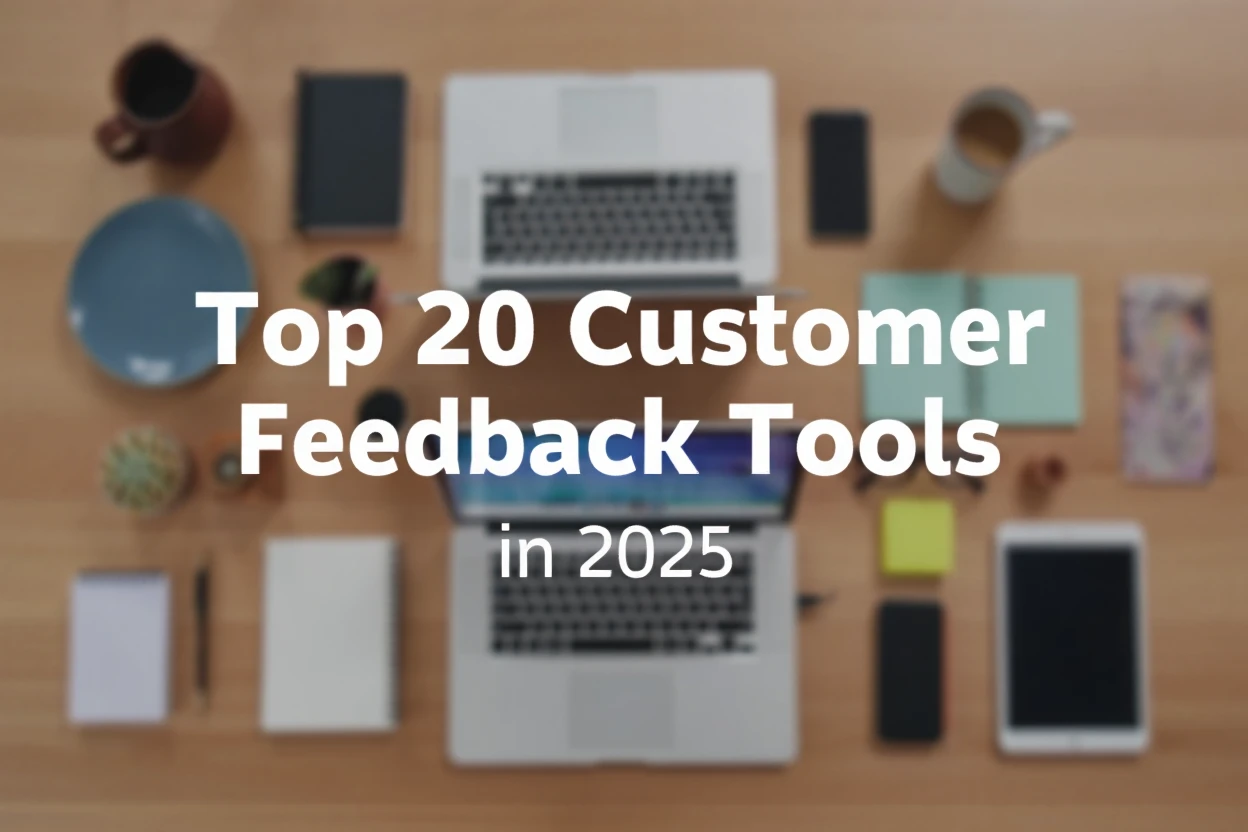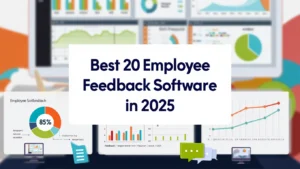Collecting customer feedback isn’t optional. If you want to survive in a saturated market, you must know what your users actually think. Whether you’re running a SaaS, eCommerce brand, or service-based business, feedback is your edge. But here’s the catch: not all feedback tools are created equal.
After testing and researching dozens of platforms, we narrowed it down to the 20 best customer feedback tools for 2025. These tools are custom-made for founders, CMOs, product managers, UX teams, and customer success departments who need insight — fast, clear, and actionable.
According to McKinsey, companies that prioritise customer feedback experience 60% higher customer retention.
A report from Qualtrics states that businesses ignoring feedback are 3x more likely to see a churn spike within 12 months.
If you’re trying to fix churn, refine product-market fit, or improve NPS, this list is for you.
What Is a Customer Feedback Tool?
A customer feedback tool helps businesses gather, organise, and act on user opinions, preferences, and complaints. Whether it’s via NPS, surveys, in-app widgets, or email triggers, these tools reveal what your customers love, hate, and want.
Why it matters:
- You spot churn signals early.
- You fine-tune your features based on user demand.
- You increase LTV by addressing concerns quickly.
- You build trust through responsiveness.
These tools often integrate with your CRM, helpdesk, product analytics, or onboarding flows to tie feedback to real user journeys.
Quick Comparison of Best Customer Feedback Tools in 2025
We chose these attributes based on what product teams, growth marketers, and CS leaders care about when picking a feedback tool.
| Tool Name | Best For | Starting Price | Free Trial | Standout Feature | G2 Rating |
| Hotjar | Behavior-based feedback | Free | Yes | Heatmaps + surveys combo | 4.3 |
| Survicate | Multichannel surveys | $53/mo | Yes | Website, email, mobile | 4.6 |
| Typeform | Beautiful forms/surveys | $25/mo | Yes | Conversational UI | 4.5 |
| Refiner | SaaS user feedback | $79/mo | Yes | Event-based micro surveys | 4.8 |
| UserReport | UX research + feedback | Custom | No | Google Analytics overlay | 4.2 |
| Qualtrics | Enterprise feedback | Custom | Yes | Advanced segmentation | 4.4 |
| GetFeedback | Salesforce users | Custom | Yes | Native Salesforce integration | 4.5 |
| AskNicely | NPS surveys for service | Custom | Yes | Slack + CRM triggers | 4.3 |
| CustomerSure | Feedback + issue tracking | $199/mo | No | Case management blend | 4.1 |
| Usersnap | Visual bug & UX feedback | $69/mo | Yes | Screenshot + annotation | 4.7 |
| Productboard | Product roadmap insights | $20/mo | Yes | prioritisation matrix | 4.6 |
| UserVoice | Feature request boards | Custom | Yes | Forum + roadmap builder | 4.3 |
| Delighted | NPS, CSAT, CES automation | Free | Yes | Autoresponders | 4.5 |
| Feedier | Reward-based feedback | $60/mo | Yes | Gamified survey experience | 4.4 |
| UseResponse | Self-hosted feedback | $149/mo | Yes | Forums + ticketing | 4.2 |
| SatisMeter | In-app NPS for SaaS | $49/mo | Yes | Slack + Intercom native | 4.4 |
| Mopinion | Web feedback at scale | Custom | Yes | Real-time dashboards | 4.3 |
| Askform | Survey alternative | $25/mo | Yes | Custom logic builder | 4.1 |
| Zonka Feedback | Kiosk + offline collection | $49/mo | Yes | Offline tablet surveys | 4.5 |
| Nicereply | Post-interaction ratings | $59/mo | Yes | Agent-based performance | 4.2 |
Best Customer Feedback Tools of 2025
Here are the platforms that made the cut.
1. Hotjar – Understand What Users Do, Not Just What They Say
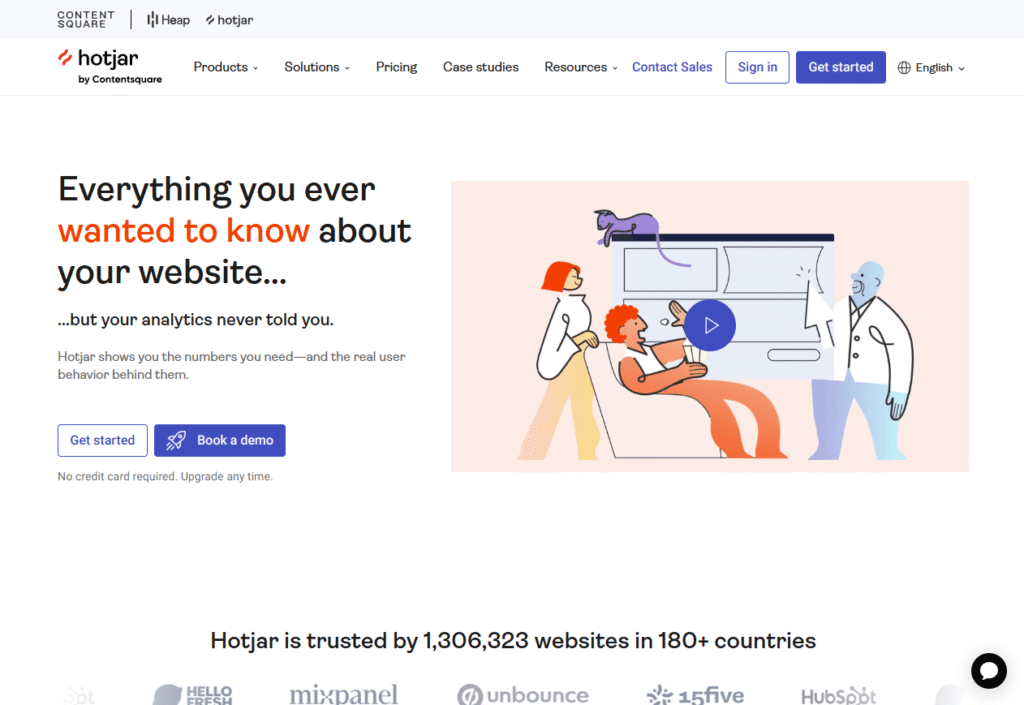
Hotjar is a behavioral analytics and feedback tool designed for product teams, marketers, and UX designers. With millions of websites using it globally, Hotjar merges heatmaps, session recordings, and feedback widgets to show you exactly where users get stuck, quit, or convert.
Whether you’re fixing leaks in your sales funnel or improving onboarding, Hotjar gives you the why behind every click.
Key Features
Heatmaps
See where users click, scroll, or stop. Hotjar heatmaps reveal which parts of your site attract attention and which ones get ignored — invaluable for optimising CTAs and navigation paths.
Session Recordings
Watch real user sessions to identify bugs, friction, and confusion. Perfect for product and UX teams refining user flows or validating design changes.
Feedback Polls
Deploy custom surveys at the right time and place. Ask visitors why they didn’t convert, what’s missing, or what they loved. Feedback appears in real time.
Incoming Feedback
Let users leave instant feedback on any page. A simple emoji-based tool gives voice to frustration or satisfaction. Great for spotting trends.
Surveys via Link or Email
Send out surveys to users post-interaction, post-purchase, or post-support ticket. Hotjar surveys are lightweight, mobile-optimised, and easy to complete.
Pros & Cons
| Pros | Cons |
| Combines analytics + feedback | Limited survey logic |
| Free tier is generous | No advanced segmentation |
| Works well with any CMS | Not suitable for long surveys |
Pricing
- Basic: Free (up to 35 daily sessions)
- Plus: $39/month
- Business: From $99/month
- Scale: Custom pricing
Best for CRO-Obsessed Product Teams
Hotjar is ideal for:
- SaaS Founders — Spot why users don’t convert or upgrade
- UX Designers — Watch real sessions to validate design tweaks
- eCommerce Managers — Catch cart drop-offs and poor UI decisions
- Agencies — Show clients where traffic is getting wasted
If you’re bleeding conversions and want real-time behavior + feedback, Hotjar is an obvious first pick.
How to Use Hotjar to Catch UX Blind Spots
Run a poll asking “Is anything stopping you from signing up today?” after 20 seconds on your pricing page. You’ll uncover objections you’d never find in analytics tools.
Best Alternative to Hotjar
Microsoft Clarity – It’s free, has session recordings, and supports heatmaps. It lacks Hotjar’s feedback features but is a great entry point if budget is tight.
2. Survicate – Surveys Where Your Users Are
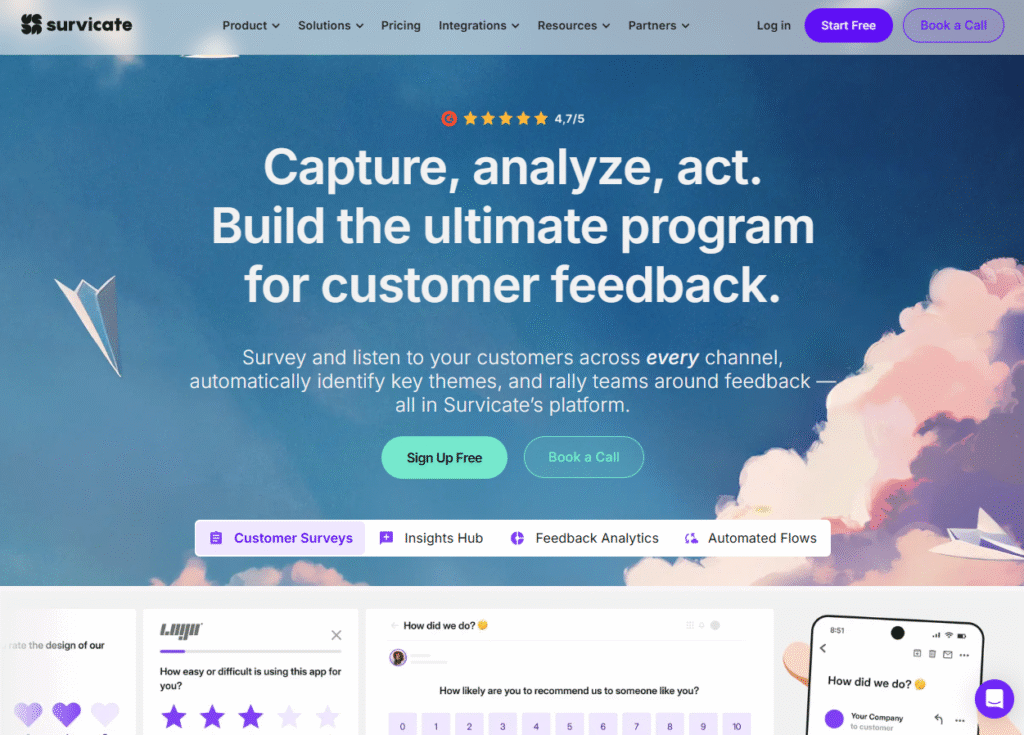
Survicate is a multichannel survey tool built for marketers, customer success teams, and product managers who need to capture user sentiment without being intrusive. Whether you’re sending emails, triggering popups, or embedding feedback forms inside your app, Survicate handles it all with precision.
Used by brands like Sony, Pipedrive, and Netguru, it’s a smart pick for companies scaling up their feedback loops.
Key Features
Website Surveys
Place targeted surveys across your website based on behavior or time on page. Ask exit-intent questions or gauge satisfaction after feature releases — no developer required.
Email & Link Surveys
Embed single-question surveys inside your newsletters, transactional emails, or post-interaction messages. Ideal for NPS, CSAT, and feature feedback.
In-App Feedback Widgets
Collect real-time feedback within your product. Trigger surveys after a key user event — like completing a task — for contextual input.
CRM Integrations
Syncs directly with HubSpot, Intercom, Mailchimp, and more. Perfect for aligning survey responses with customer lifecycle data.
Question Logic
Build smart branching surveys that adapt based on user input. Keeps forms short and focused, boosting completion rates.
Pros & Cons
| Pros | Cons |
| Multichannel support | UI can feel clunky |
| Strong integrations | Some limits on customisation |
| Built-in templates | Advanced analytics extra |
Pricing
- Free Plan: Basic surveys (100 responses/month)
- Start: $53/month
- Business: Custom pricing for advanced features
Best for Teams Running Multi-Channel Campaigns
Survicate is built for:
- Product Managers — Trigger surveys based on in-app behavior
- Marketers — Launch feedback campaigns via email and popups
- Customer Success Teams — Monitor satisfaction without friction
- Growth Leads — Map feedback to lifecycle stages
If you need surveys on email, web, and product — without juggling 3 tools — Survicate is your best bet.
Use Survicate to Measure Feature Adoption
Trigger a survey asking “Was this feature helpful?” immediately after a user engages with a new release. You’ll know instantly if it’s a win or a flop.
Best Alternative to Survicate
Refiner – More customised for SaaS and startup environments, Refiner provides behavior-based survey targeting and deeper segmentation. Worth comparing for tech-heavy teams.
3. Typeform – Make Feedback Feel Like a Conversation

Typeform is for brands that care about how they ask, not just what they ask. With a clean, one-question-at-a-time format, it makes surveys feel more human — not robotic forms. This is the go-to for design-first teams, marketers, and creators who value user experience.
Used by companies like Apple, Airbnb, and Uber, Typeform is as much about user experience as it is about data.
Key Features
Conversational Interface
Typeform’s unique layout guides users through questions one at a time, keeping them engaged. Great for long-form feedback, lead gen, or experience mapping.
Drag-and-Drop Builder
Easily build branded forms and surveys without writing a line of code. Custom logic, embedded media, and styling make it visually appealing.
Conditional Logic
Ask smarter questions. Set rules based on previous answers to show only relevant follow-ups. This shortens surveys and improves completion rates.
Integrations with Zapier, HubSpot, and Slack
Connect Typeform with CRMs, marketing tools, or internal comms to automate feedback workflows without switching tabs.
Embedded Surveys
Place your surveys on landing pages, inside onboarding flows, or blog posts without breaking design consistency.
Pros & Cons
| Pros | Cons |
| Beautiful and on-brand | Pricier than alternatives |
| High response rates | Limited analytics depth |
| Flexible logic flows | Not ideal for NPS workflows |
Pricing
Best for Brands Focused on UX and Design
Typeform is a top pick for:
- Marketing Teams — Make lead-gen surveys more engaging
- Product Designers — Gather feedback that doesn’t feel like a chore
- eCommerce Brands — Post-purchase surveys that don’t ruin the vibe
- Content Creators — Embed interactive forms into blog posts and courses
If brand image and experience matter more than analytics depth, Typeform is your feedback tool.
Use Typeform to Increase Completion Rates
Switch from bulky forms to a Typeform format with visual icons and progress bars. Watch your survey response rate go up by 30% or more.
Best Alternative to Typeform
Askform – Offers a similar conversational interface but with more flexible pricing. A leaner, less design-heavy option for startups or early-stage brands.
4. Refiner – Precision Feedback for SaaS Growth
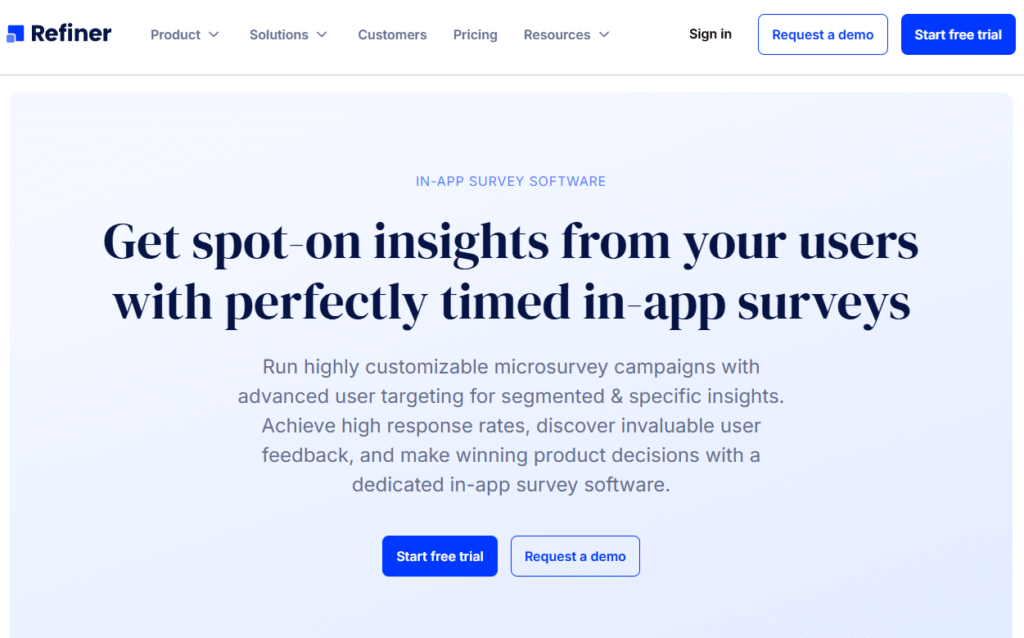
Refiner is built specifically for SaaS companies that need feedback to be targeted, timely, and deeply actionable. Unlike generic survey tools, Refiner ties surveys to product usage, lifecycle stages, and user events. This gives growth teams the data they need without interrupting users unnecessarily.
If you want hyper-focused micro-surveys triggered by real behavior, Refiner’s your pick.
Key Features
Event-Based Targeting
Trigger surveys based on in-app behavior — like completing a feature or hitting a usage milestone. Perfect for gathering feedback when context matters most.
Micro-Surveys
Launch 1-2 question surveys that don’t feel intrusive. These bite-sized polls fit natively within your app and boost response rates.
Segmentation
Target users by attributes like pricing tier, activation status, location, or behavior. Great for customising questions and filtering responses.
Native Integrations
Connect with Segment, Intercom, Customer.io, HubSpot, and more. That means faster implementation and fewer manual workflows.
Custom Branding
Match surveys to your product UI for a clean, non-disruptive look. Design flexibility without code.
Pros & Cons
| Pros | Cons |
| Built for SaaS from day one | Not ideal for offline surveys |
| Powerful targeting | Limited external survey support |
| Slick UX for micro-surveys | Smaller template library |
Pricing
- Startup Plan: $79/month
- Growth Plan: $159/month
- Enterprise: Custom pricing
Best for SaaS Teams Needing Event-Triggered Feedback
Refiner is a match for:
- SaaS Product Managers — Collect feedback post-feature usage
- Customer Success Leaders — Trigger NPS based on lifecycle stage
- Growth Marketers — Capture conversion blockers in real time
- Founders — Validate if users see real value
If you’re serious about feedback loops in your SaaS, Refiner’s targeting and event logic are worth every penny.
How to Use Refiner to Prevent Churn
Set an NPS survey to trigger 15 days before a subscription renewal. Catch dissatisfied users before they cancel — and proactively resolve issues.
Best Alternative to Refiner
SatisMeter – Built for SaaS too, and slightly cheaper. Great for NPS surveys but lacks the advanced targeting logic that sets Refiner apart.
5. UserReport – Feedback That Integrates With Your Analytics
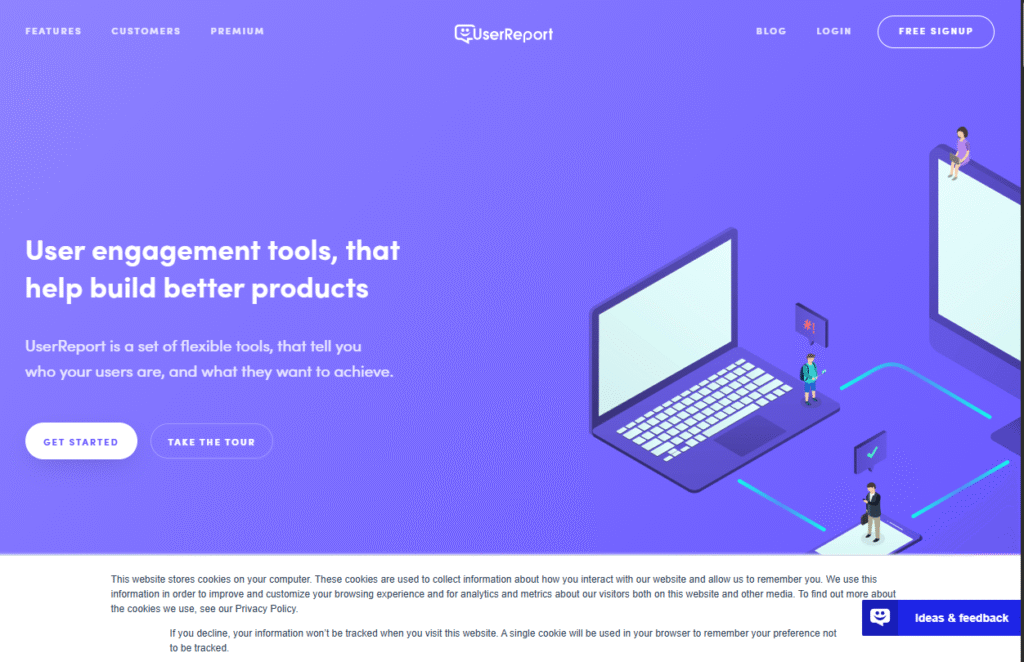
UserReport combines user feedback with your Google Analytics data, giving marketers and product managers a broader understanding of who’s using the product — and what they think. With its simple integration and focus on UX and audience segmentation, UserReport is ideal for digital publishers, content-heavy platforms, and media brands.
It’s less flashy but highly functional for teams that already lean on GA for decision-making.
Key Features
Google Analytics Overlay
Overlay survey and feedback data directly onto your GA dashboard. Match opinions with user behavior and refine both content and UX strategies.
Net Promoter Score (NPS)
Run quick NPS surveys on your site to measure loyalty and benchmark user satisfaction across segments and traffic sources.
Feedback Forum
Let users suggest improvements or report bugs. You can prioritise based on votes, giving users a sense of involvement and transparency.
Audience Profiling
Build demographic profiles using data collected through surveys. Combine this with GA traffic patterns to guide product and content decisions.
Lightweight Widgets
Deploy unobtrusive feedback widgets across your website or app. Easy to customise and quick to set live — no engineering bottlenecks.
Pros & Cons
| Pros | Cons |
| Syncs with GA | Not built for mobile apps |
| Anonymous audience profiling | Limited visual customisation |
| Great for media/content sites | Interface feels outdated |
Pricing
- Custom Plans Only – Contact for a quote. Pricing depends on monthly traffic and features used.
Best for Analytics-Focused Product Teams
UserReport shines for:
- Digital Publishers — Connect reader sentiment with traffic data
- UX Researchers — Blend qualitative and behavioral metrics
- Marketers — Improve campaigns based on actual audience feedback
- Product Teams — Validate feature ideas with open suggestions
If your workflow revolves around GA and content performance, UserReport bridges the gap between numbers and user voice.
Use UserReport to Validate Personas
Deploy a quick demographic survey to your blog readers, then sync with GA to see how each persona behaves. You’ll refine your ICP without guessing.
Best Alternative to UserReport
Mopinion – More enterprise-friendly and focused on high-volume websites. Offers real-time dashboards and deeper analytics but lacks UserReport’s GA integration.
6. Qualtrics – Enterprise-Grade Feedback Intelligence

Qualtrics is the heavyweight of the feedback world — built for enterprises that need rigorous data, advanced segmentation, and secure infrastructure. Trusted by over 13,000 brands including Microsoft and BMW, it’s designed for research teams, CX leaders, and product owners who want full control over survey logic, distribution, and analytics.
If feedback is a core business function for you, not just a feature, Qualtrics stands out.
Key Features
Advanced Survey Logic
Design complex, multi-path surveys using branching, quotas, skip logic, and embedded data. This is research-level power in a drag-and-drop interface.
Experience Management (XM) Platform
Go beyond surveys. Track user experiences across customer, employee, product, and brand touchpoints. Connect feedback to business KPIs.
Real-Time Dashboards
Build live dashboards for different departments or execs. Filter responses by channel, persona, or location to drive faster decisions.
Distribution Channels
Send surveys via SMS, email, app, web intercepts, or QR codes. Ideal for global teams managing diverse audiences.
Enterprise Security
SOC2 compliance, single sign-on (SSO), and data governance tools make Qualtrics safe for industries like healthcare, finance, and government.
Pros & Cons
| Pros | Cons |
| Full control over survey design | Steep learning curve |
| Works across departments | Pricey for smaller teams |
| Scales globally | Overkill for simple use cases |
Pricing
- Custom Pricing Only – Typically starts at $5,000/year and scales with usage.
Best for Enterprises and Large Product Teams
Qualtrics fits:
- Enterprise CX Managers — Tie feedback to organisational OKRs
- Product Leaders — Run pre-launch concept testing at scale
- UX Researchers — Deploy academic-grade surveys and analysis
- HR Teams — Run employee engagement and satisfaction programs
If feedback influences company-wide decisions, budget approvals, and OKRs, Qualtrics is your long-game partner.
Use Qualtrics to Link Feedback with Revenue
Integrate feedback with your CRM and analytics tools to see how satisfaction scores correlate with upsell, renewal, or churn metrics.
Best Alternative to Qualtrics
GetFeedback – customised more for Salesforce users, with a user-friendly UI and faster setup. Lacks the research depth but hits the right notes for mid-sized teams.
7. GetFeedback – Built for Salesforce, Powered by Simplicity

GetFeedback is purpose-built for teams already using Salesforce. It collects real-time feedback through email, SMS, chat, and web, and syncs everything directly into your CRM. This gives sales, marketing, and support teams immediate visibility into customer sentiment — without logging into another dashboard.
If you’re deep in the Salesforce ecosystem and need fast, contextual feedback, GetFeedback is the no-brainer.
Key Features
Native Salesforce Integration
Surveys and responses link automatically to leads, contacts, or accounts in Salesforce. This enables automated workflows based on feedback scores.
Multi-Channel Distribution
Send surveys via email, SMS, live chat, or embed them in your app. Choose the channel that matches each customer touchpoint.
Real-Time Alerts
Trigger internal alerts based on low NPS or CSAT scores. Perfect for initiating fast follow-up with unhappy customers.
Mobile-optimised Templates
Design surveys that work seamlessly on any device. Ideal for post-support feedback or quick transactional polls.
Reporting Dashboards
Visualise NPS, CSAT, and CES metrics inside your Salesforce environment. No need to export or reformat data manually.
Pros & Cons
| Pros | Cons |
| Seamless Salesforce integration | Less flexible for non-SF users |
| Clean, modern survey templates | Pricing not transparent |
| Great for support + CSAT | Fewer advanced logic features |
Pricing
- Custom Pricing – customised per seat and usage volume; must request a quote.
Best for Salesforce-Centric Customer Ops
GetFeedback suits:
- Support Managers — Gather CSAT post-ticket closure
- Sales Ops Teams — Link feedback to lead and deal records
- Customer Success Leaders — Automate NPS follow-up workflows
- Service-Based Teams — Collect ratings immediately after service delivery
For Salesforce-heavy orgs needing immediate customer sentiment visibility, GetFeedback wins on speed and integration depth.
Use GetFeedback for Real-Time Escalation
Set up an auto-alert in Salesforce that notifies the CS team when an NPS falls below 6. You’ll prevent churn before it escalates into a support nightmare.
Best Alternative to GetFeedback
AskNicely – Focused on service teams and NPS automation, with strong CRM integrations and Slack alerts. A strong pick if you’re not 100% tied to Salesforce.
8. AskNicely – NPS Surveys with Actionable Workflows

AskNicely is focused entirely on helping service-led businesses improve customer experience using real-time feedback. It’s not just about collecting Net Promoter Scores — it’s about taking action immediately, routing insights to the right teams, and turning frontline staff into loyalty drivers.
Popular among agencies, support-heavy orgs, and field service providers, AskNicely is designed for speed and internal alignment.
Key Features
Automated NPS Surveys
Send recurring, automated NPS surveys via email, SMS, or app triggers. Get regular snapshots of customer loyalty — daily, weekly, or monthly.
Frontline Coaching
Turn NPS feedback into coaching moments. The platform includes tools to review agent performance and offer personalised training suggestions.
Slack and CRM Integration
Route negative feedback directly into your CRM or Slack, creating real-time escalation loops and fast problem resolution.
Survey customisation
Use branded templates and multi-language support to create personalised experiences that reflect your service ethos.
Feedback Leaderboards
Highlight high-performing team members based on customer reviews. Great for motivating reps and promoting accountability.
Pros & Cons
| Pros | Cons |
| Excellent for service orgs | Limited outside NPS/CSAT formats |
| Integrated agent performance | Not ideal for complex UX feedback |
| High automation potential | Pricing not public |
Pricing
- Custom Pricing – Based on team size, volume, and integrations. Book a demo for a quote.
Best for Service-Based Teams Focused on NPS
AskNicely is ideal for:
- Support Leaders — Benchmark and coach agents using customer feedback
- Ops Managers — Automate internal workflows based on NPS responses
- Field Service Brands — Gauge satisfaction after every service touchpoint
- Sales & CS Teams — Close the loop on low ratings in real time
If your business lives or dies on service quality and referrals, AskNicely turns NPS into action, not just a vanity score.
Use AskNicely to Improve Frontline Coaching
Pair negative NPS responses with 1:1 coaching prompts. Help agents learn from real interactions — and raise team-wide service quality within weeks.
Best Alternative to AskNicely
Nicereply – Also built for support and post-interaction feedback. It allows for CSAT and CES ratings in addition to NPS, with flexible ticket-level tracking.
9. CustomerSure – Feedback That Drives Accountability
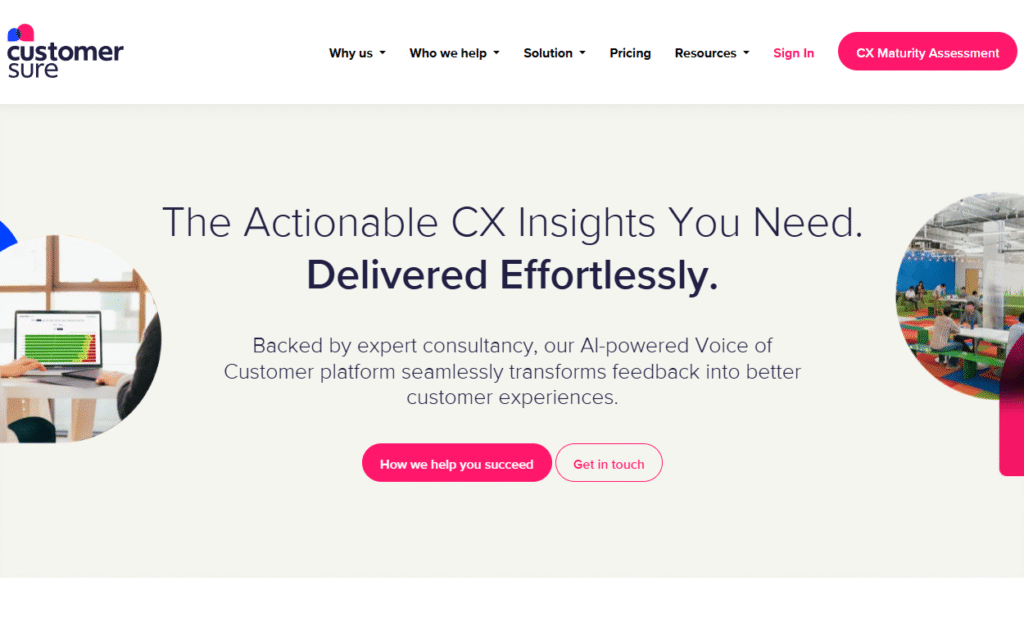
CustomerSure isn’t just a survey tool — it’s a complete feedback resolution platform. Built for B2B service providers and customer success teams, it ensures that every piece of feedback is acknowledged, acted upon, and tracked to resolution. If you’ve ever felt that NPS scores vanish into a black hole, CustomerSure fixes that.
Its focus on operationalizing feedback makes it a go-to for companies that care about retention and reputation.
Key Features
Feedback + Issue Tracking
Every piece of feedback becomes a “case” that your team can assign, escalate, and close. You’ll never lose track of a complaint or suggestion.
Post-Transaction Surveys
Trigger feedback forms after a ticket is resolved, a delivery is made, or a milestone is hit. Keep questions context-specific and actionable.
Real-Time Alerts
Get notified immediately when someone leaves low feedback. Automatically assign it to a specific person for follow-up.
Transparent Reporting
Built-in analytics show how fast you respond to feedback, how often you follow up, and what trends emerge across teams.
Branded Templates
Design feedback forms that match your branding without needing developers. Maintain trust and consistency across channels.
Pros & Cons
| Pros | Cons |
| Strong accountability framework | UI could use modernization |
| Built for follow-through | Limited integrations |
| Great for B2B service teams | Expensive starting tier |
Pricing
- Essentials Plan: $199/month
- Professional: Custom pricing based on volume and teams
Best for B2B Teams That Need Feedback Action Plans
CustomerSure is best suited for:
- CS Managers — Resolve complaints before they affect renewals
- B2B Account Teams — Keep clients happy with clear feedback loops
- Ops Directors — Track how feedback is handled across locations or regions
- Logistics/Service Providers — Use feedback to improve SLA compliance
If your biggest challenge is acting on feedback — not just collecting it — CustomerSure forces the accountability needed to improve.
Use CustomerSure to Win Back Detractors
Set up an automatic follow-up message from the account manager when a low score comes in. Include a link to schedule a call and track the resolution status directly in the platform.
Best Alternative to CustomerSure
Delighted – Lighter, cheaper, and more flexible for general CSAT/NPS. But it lacks the case-management system that makes CustomerSure unique.
10. Usersnap – Visual Feedback Built for Dev and Product Teams
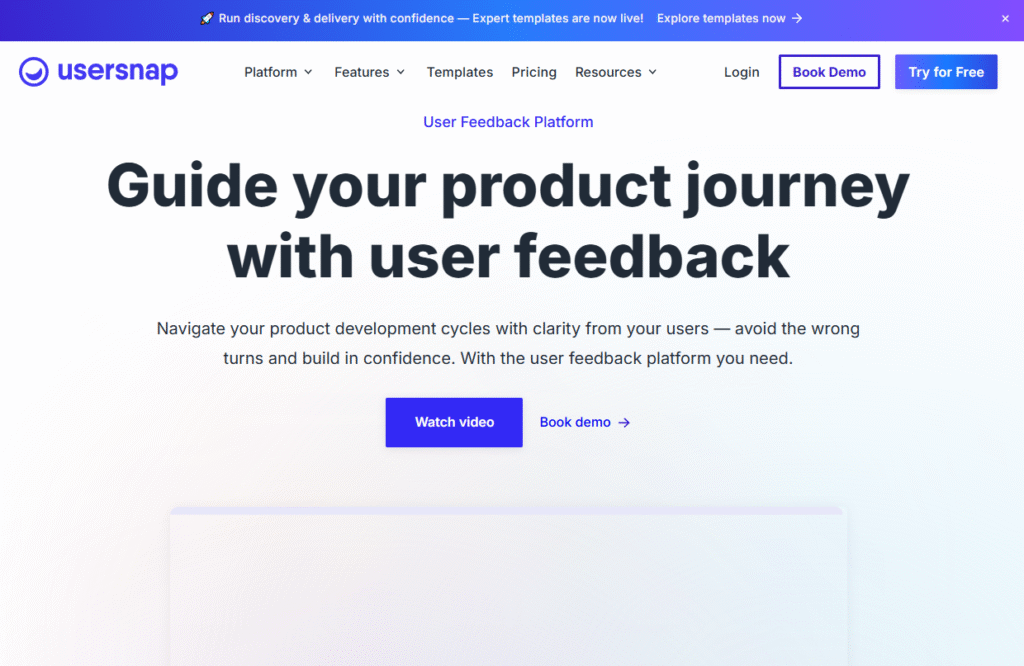
Usersnap gives product managers, developers, and designers a way to collect visual, contextual feedback right from the user’s screen. With screenshot-based reporting and in-app feedback widgets, Usersnap eliminates the guesswork in bug reports and UI suggestions.
If you’re tired of vague feedback like “It’s broken,” Usersnap shows you exactly what the user saw — and when.
Key Features
Screenshot-Based Feedback
Users can highlight UI issues, add comments, and capture exactly what’s on their screen. This is gold for frontend teams and QA testers.
In-App Feedback Widgets
Place feedback buttons or surveys inside your web app. Great for collecting contextual product suggestions or reporting bugs.
Integration with Project Management Tools
Connect with Jira, Trello, Slack, or Asana to push feedback directly into your workflow. Your dev team will actually see the problem.
Customizable Workflows
Tag feedback, assign to team members, and track resolution stages. Keeps your team accountable and focused on continuous improvement.
NPS, CSAT & Feature Requests
Run standard surveys and maintain a public or private roadmap where users can upvote new feature ideas.
Pros & Cons
| Pros | Cons |
| Visual context improves accuracy | Learning curve for non-tech users |
| Developer-friendly integrations | Pricing may deter smaller startups |
| Excellent for bug reporting | Best for web apps, not mobile |
Pricing
- Basic: $69/month
- Startup: $129/month
- Company: $249/month
- Enterprise: Custom pricing
Best for Product Teams That Need Visual Context
Usersnap is perfect for:
- Frontend Devs — Identify and reproduce bugs faster
- UX Teams — Collect design-specific feedback post-launch
- QA Testers — Document issues without writing technical steps
- Product Managers — Triage user feedback during sprint planning
If you’re shipping fast and want user-reported issues to be useful, Usersnap adds clarity and speed to every bug and idea.
Use Usersnap to Streamline QA and Sprint Feedback
Install Usersnap on your staging environment. Internal testers and beta users can report issues instantly, with annotated screenshots sent directly to Jira.
Best Alternative to Usersnap
UseResponse – Offers visual feedback and ticketing but leans more toward customer support than dev teams. Still, a viable option for multi-role platforms.
11. Productboard – prioritise What Actually Matters
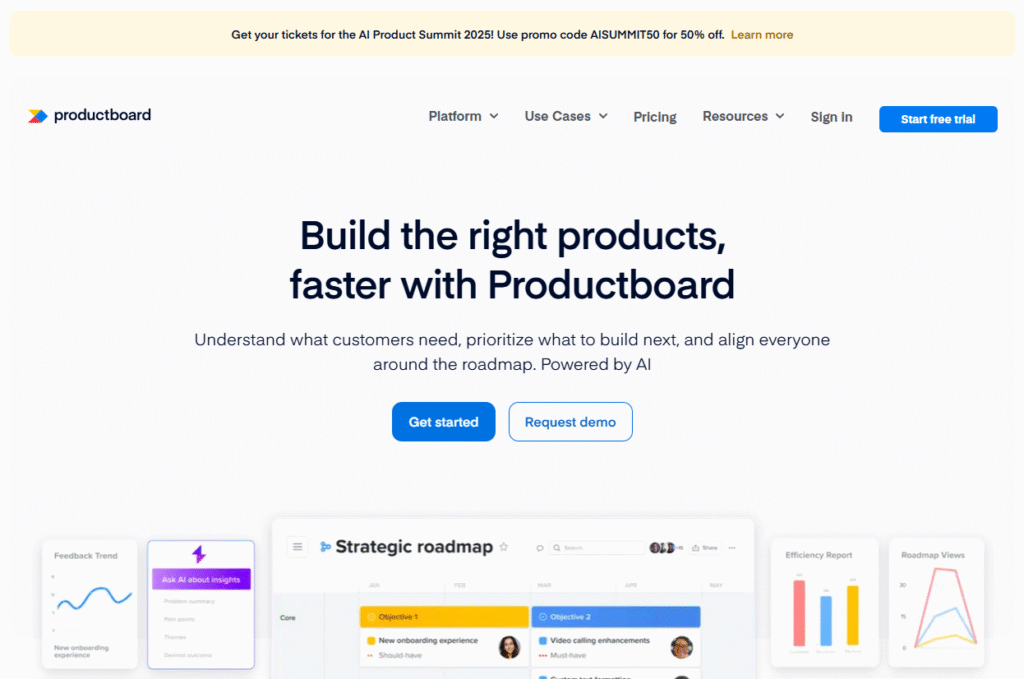
Productboard is a product management platform with built-in feedback collection. Unlike traditional survey tools, it helps product teams collect, organise, and act on user feedback by connecting it to their roadmap. If you’re drowning in feature requests and can’t decide what to build next, Productboard makes prioritisation crystal clear.
Used by brands like Zendesk, Microsoft, and Avast, it’s built for product-led growth.
Key Features
Feedback Portal
Collect feature requests from users via a branded portal. Stakeholders can upvote, comment, or share ideas, helping your team crowdsource demand.
prioritisation Matrix
Evaluate features based on customer impact and business goals. Use Productboard’s framework or create your own scoring model to drive smarter decisions.
Roadmap Sharing
Communicate your upcoming features and timelines to internal teams or users. Build transparency and alignment across departments.
Feedback Consolidation
Aggregate input from emails, support tickets, calls, and sales conversations into one place. Link them to relevant feature ideas to track demand.
Jira and Dev Integrations
Push prioritised features directly into your development cycle. Sync with Jira, Azure DevOps, or GitHub for seamless implementation.
Pros & Cons
| Pros | Cons |
| Ties feedback to roadmap | Requires strong internal processes |
| Clear prioritisation framework | More product-focused than CSAT |
| Scales across teams | Not ideal for standalone surveys |
Pricing
- Starter: $20/month per maker
- Pro: $80/month per maker
- Scale/Enterprise: Custom pricing
Best for Product-Led Teams Prioritizing Features
Productboard is ideal for:
- Product Managers — Turn raw feedback into structured product decisions
- Startup Founders — Validate roadmap decisions with user demand
- Customer Success Teams — Advocate for high-impact feature requests
- Dev Teams — Reduce feedback overload and noise
If your backlog is a graveyard of ideas and internal debates, Productboard gives structure to feedback chaos.
Use Productboard to Build What Your Best Customers Want
Link customer segments to feature requests. prioritise what your top-paying users care about most — and increase retention by delivering real value.
Best Alternative to Productboard
UserVoice – Also focused on product feedback and roadmapping. Offers a public voting board and integrates well with enterprise stacks, but lacks Productboard’s detailed prioritisation matrix.
12. UserVoice – Let Customers Shape Your Product Roadmap
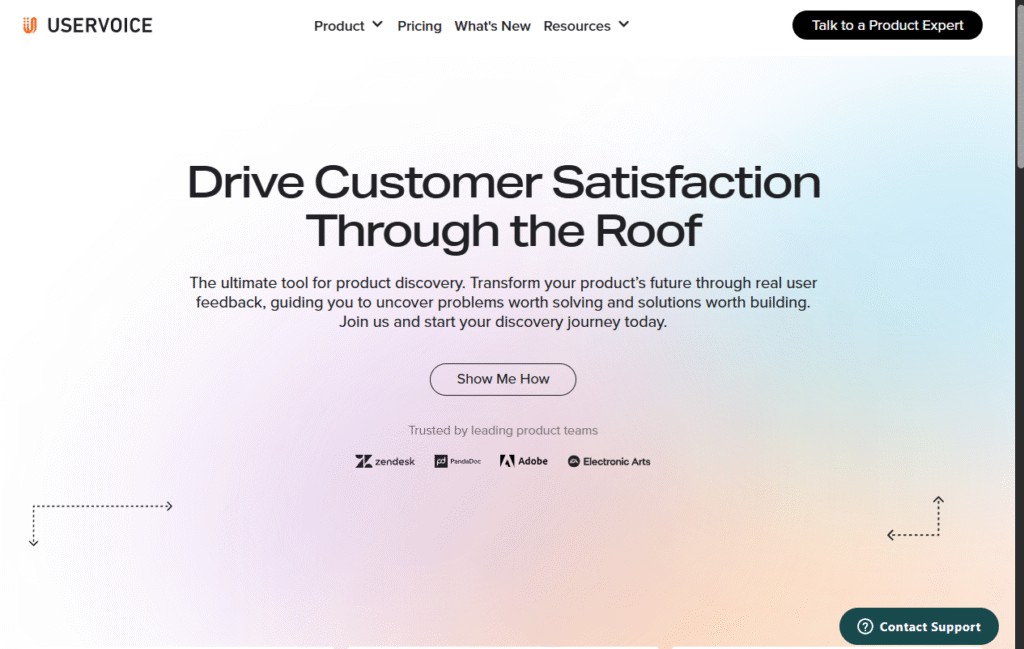
UserVoice is built for mid-to-large SaaS companies that want to organise feature requests, track user sentiment, and close the feedback loop at scale. It turns passive suggestions into structured product insights by giving users a place to vote, comment, and follow updates.
If you want a customer-facing feedback system tied directly to your development process, UserVoice checks every box.
Key Features
Feedback Portal
Create a branded, public-facing feedback board where customers can submit ideas, vote on suggestions, and see what’s under review or in progress.
Idea prioritisation
Automatically surface the most valuable requests based on voting patterns, customer segments, and internal business rules.
Internal Feedback Routing
Capture internal suggestions from sales, support, and success teams. Tag, track, and assign them to product managers within a single hub.
Roadmap Publishing
Publish a live roadmap that syncs with your actual feature status. Great for transparency and customer engagement.
CRM & Support Integrations
Connect UserVoice with tools like Salesforce, Zendesk, and Intercom to sync user feedback across your tech stack.
Pros & Cons
| Pros | Cons |
| Great for user-driven roadmaps | Limited survey-style feedback |
| Public voting builds community | UI feels a bit outdated |
| Tracks suggestions to launch | Higher entry price |
Pricing
- Essentials Plan: Starts at $799/month
- Premium/Enterprise: Custom pricing
Best for SaaS Companies Building With Customer Input
UserVoice fits perfectly for:
- Product Teams — Crowdsource and filter feature requests
- Customer Success Managers — Represent customer needs in roadmap planning
- SaaS Founders — Align roadmap with revenue-driving features
- Support Teams — Deflect repetitive “what’s coming next?” questions
If customer ideas matter to your roadmap strategy, UserVoice offers transparency and structured prioritisation in one place.
Use UserVoice to Engage Your Top Advocates
Send VIP users early access to new features and ask them to share feedback on the board. You’ll gather higher-quality insights and make your champions feel heard.
Best Alternative to UserVoice
Canny – Similar in purpose but more modern and budget-friendly. It offers voting boards, changelogs, and integrations without the enterprise-level cost.
13. Delighted – Simple, Automated Customer Feedback
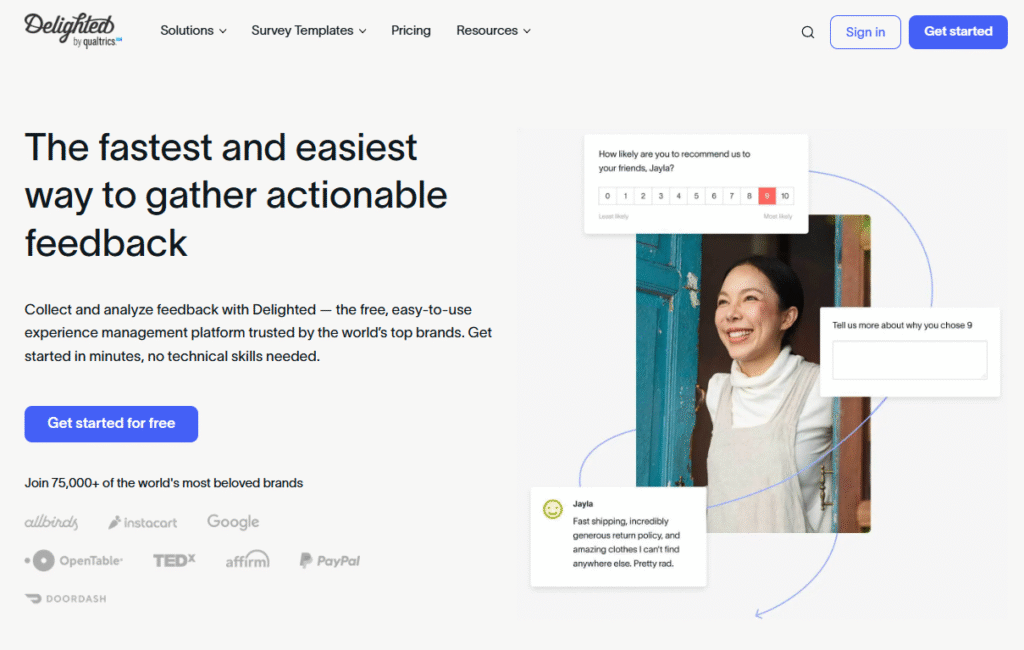
Delighted is one of the easiest tools to deploy if you want NPS, CSAT, or CES surveys running within minutes. Acquired by Qualtrics, it keeps things lightweight compared to its parent platform, making it perfect for startups and mid-market businesses that don’t need heavy research features.
It’s automation-first — surveys go out without you having to constantly manage them.
Key Features
Multi-Channel Surveys
Send NPS, CSAT, or CES surveys via email, SMS, website popups, or app integrations. Meet customers where they already are.
Autoresponders
Trigger automatic follow-up messages based on scores. For instance, send a thank-you note for promoters or escalate detractors to customer success.
Pre-Built Templates
Get started fast with templates optimised for NPS, post-purchase surveys, or support interactions.
Analytics Dashboard
View trends across time, break down responses by customer segment, and benchmark scores against industry standards.
Integrations
Works with Slack, Zendesk, HubSpot, and Shopify to bring customer insights into your daily workflows.
Pros & Cons
| Pros | Cons |
| Super easy to set up | Limited customisation |
| Works with many channels | Less depth than Qualtrics |
| Affordable starting plan | Not built for complex logic flows |
Pricing
- Free: Up to 100 responses/month
- Premium: $224/month
- Enterprise: Custom pricing
Best for Startups and Growth-Stage Businesses
Delighted works best for:
- eCommerce Brands — Post-purchase satisfaction surveys
- Support Teams — CSAT surveys after ticket closure
- Growth Marketers — Automated NPS tracking for cohorts
- Founders — Lightweight setup without steep learning curves
If you want automation, speed, and simplicity, Delighted gets you running in under an hour.
Use Delighted to Automate Promoter Referrals
Set an autoresponder asking promoters if they’d like to refer a friend. Tie it into your referral program for organic growth.
Best Alternative to Delighted
SatisMeter – Similar in simplicity but with more SaaS-focused integrations like Intercom and Segment. A strong contender if your product is app-based.
14. Feedier – Reward-Based Feedback That Users Enjoy Giving
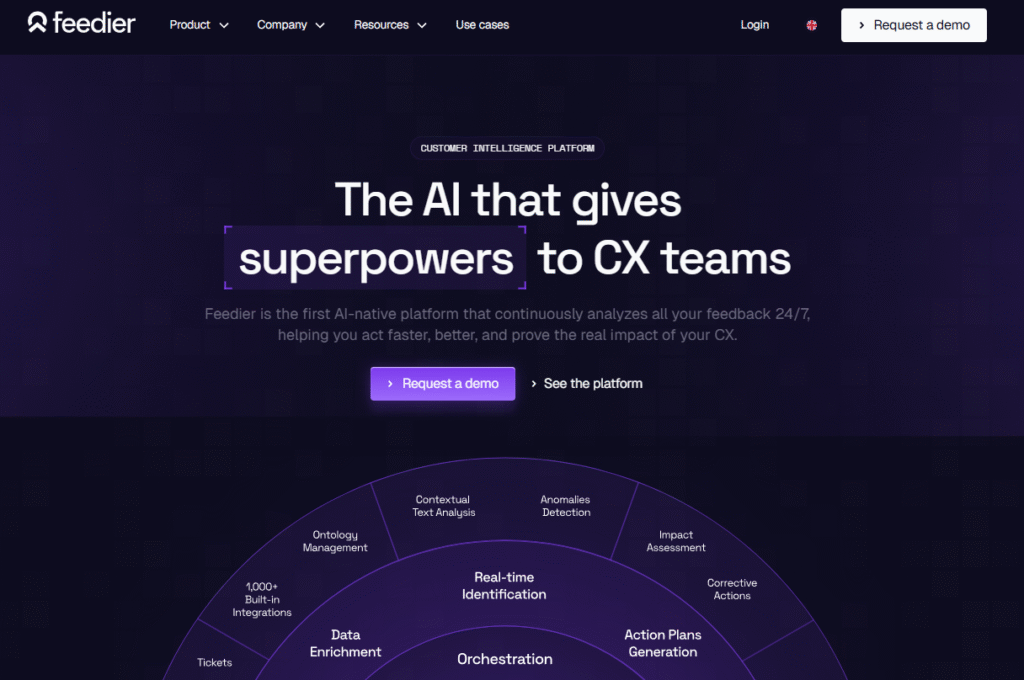
Feedier adds a gamified twist to customer feedback by offering incentives like vouchers, discounts, or loyalty points for completing surveys. Instead of struggling to get responses, you create a feedback loop that feels rewarding. It’s particularly popular with eCommerce, retail, and hospitality brands that want to increase survey participation.
Key Features
Reward Integration
Offer instant incentives such as gift cards, coupons, or loyalty points after survey completion. Increases response rates significantly.
Gamified Surveys
Interactive question formats make the process feel less like a chore. Users engage more, and you get better quality insights.
Advanced Reporting
Segment results by demographic, purchase history, or survey channel. Visualise trends in customizable dashboards.
Multi-Channel Distribution
Send surveys via email, QR code, SMS, or embed them in receipts, making it versatile for both online and offline feedback collection.
API and CRM Integrations
Connect feedback to your CRM or marketing platform. Perfect for triggering personalised follow-up campaigns.
Pros & Cons
| Pros | Cons |
| High survey completion rates | Rewards add extra costs |
| Fun, engaging user experience | Not ideal for formal B2B surveys |
| Works across industries | Limited advanced logic features |
Pricing
- Starter: $60/month
- Business: $200/month
- Enterprise: Custom pricing
Best for Brands That Need Higher Survey Engagement
Feedier is ideal for:
- eCommerce Stores — Collect post-purchase reviews with discount incentives
- Hospitality Businesses — Encourage guests to share experiences in exchange for perks
- Retailers — Use QR-based surveys at checkout with instant vouchers
- Marketing Teams — Increase completion rates on customer research
If survey fatigue is killing your response rates, Feedier’s reward-based model keeps customers engaged and willing to share feedback.
Use Feedier to Collect Post-Purchase Feedback
Add a QR code to receipts that links to a short survey with a discount reward. You’ll increase response volume while driving repeat sales.
Best Alternative to Feedier
Zonka Feedback – Similar in its versatility but with more offline and kiosk-based survey capabilities, especially suited for physical retail and events.
15. UseResponse – All-in-One Feedback, Helpdesk, and Community Hub
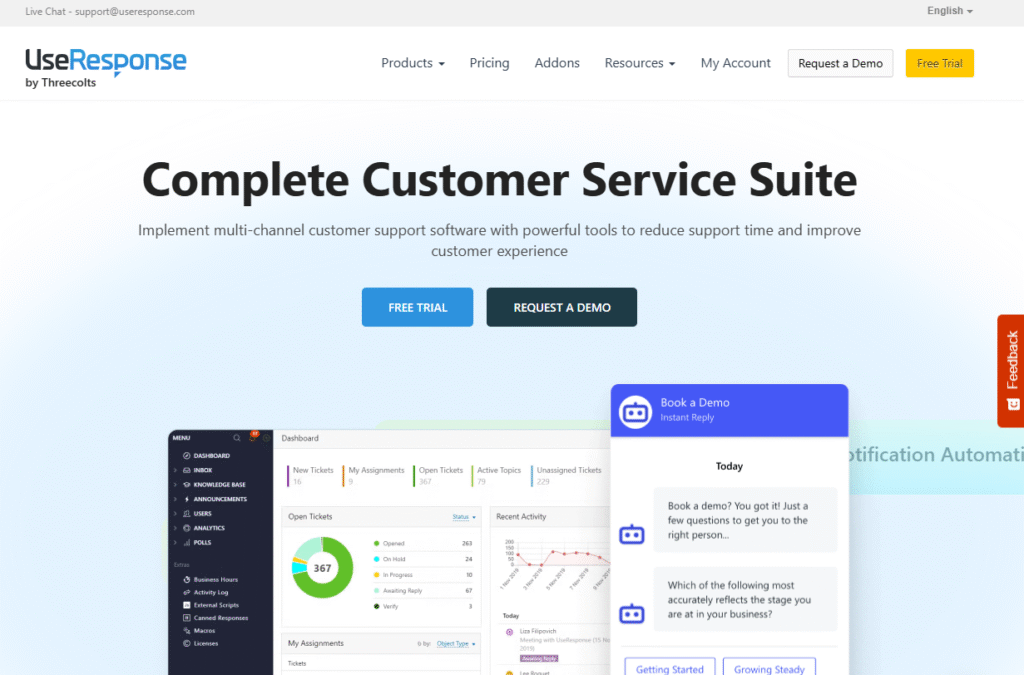
UseResponse is more than a survey tool — it’s a full feedback management and customer support platform. It combines forums, ticketing, live chat, and knowledge bases with feedback collection, making it especially valuable for SaaS, enterprise, and customer-centric teams that need everything in one ecosystem.
If you’re looking for a self-hosted or on-premises option, UseResponse stands out among feedback tools.
Key Features
Feedback & Idea Boards
Host private or public forums where customers can submit ideas, vote, and comment. Perfect for capturing feature requests and product suggestions.
Ticketing System
Convert user feedback into tickets, assign them to your team, and track their resolution. Eliminates the disconnect between feedback and action.
Live Chat & Helpdesk
Built-in chat and multi-channel support system so teams can manage feedback and support from a single interface.
Knowledge Base Integration
Publish FAQs, articles, and guides. Users can search solutions while also leaving feedback if something is missing.
White-Label & Self-Hosting
Deploy as SaaS or host it on your own servers for data control. Ideal for industries with stricter compliance needs.
Pros & Cons
| Pros | Cons |
| Combines support + feedback tools | Setup requires more configuration |
| Self-hosted option available | Interface isn’t as modern as peers |
| Good for compliance-heavy teams | Higher learning curve |
Pricing
- Feedback + Helpdesk: $149/month
- Omnichannel Suite: $490/month
- Self-Hosted License: One-time fee (custom pricing)
Best for Companies Wanting Support + Feedback in One Place
UseResponse is a great match for:
- Enterprise IT Teams — Centralise support tickets and product feedback
- SaaS Companies — Manage customer issues and roadmap suggestions in one hub
- Compliance-Focused Industries — Keep data on-premises with a self-hosted setup
- Customer Support Leaders — Reduce silos between support and product teams
If you want an integrated feedback + support platform (and possibly need self-hosting), UseResponse is one of the few tools that ticks every box.
Use UseResponse for Feature Transparency
Create a public feature board where users can suggest improvements and vote. Tie this directly to your roadmap and support tickets for accountability.
Best Alternative to UseResponse
Usersnap – Better suited for product/UX teams needing visual feedback, though it doesn’t offer the all-in-one support suite that UseResponse provides.
16. SatisMeter – Lightweight NPS for SaaS Teams
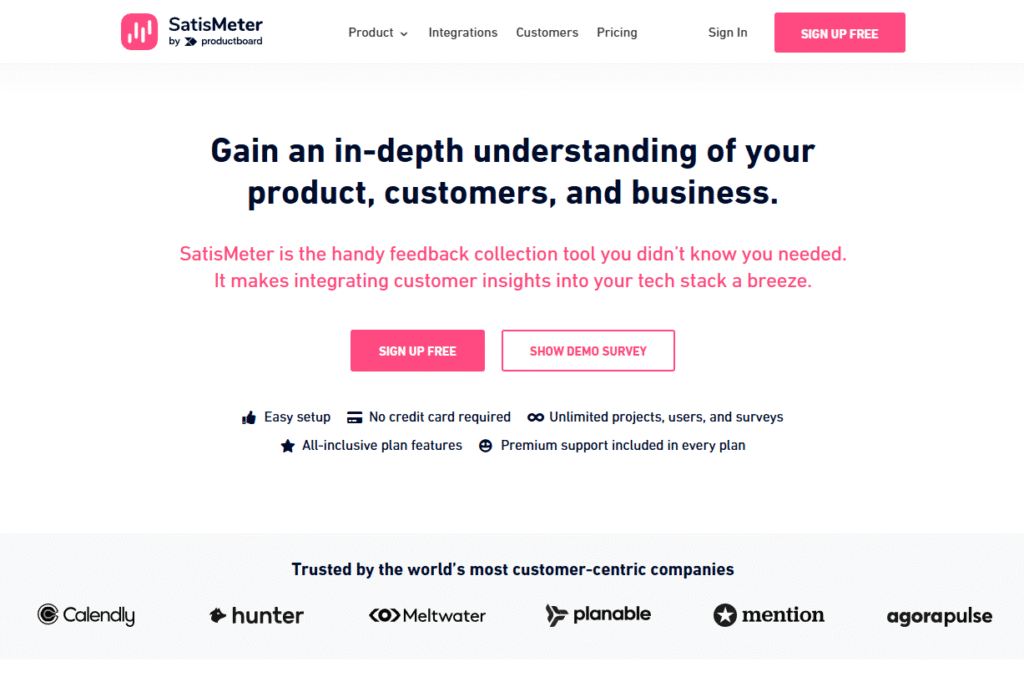
SatisMeter is built specifically for SaaS companies that want quick, in-app surveys without bloating their tech stack. It focuses on Net Promoter Score (NPS), Customer Satisfaction (CSAT), and Customer Effort Score (CES), keeping things simple but highly effective.
With integrations into tools like Intercom, Segment, and Slack, it plugs directly into workflows SaaS teams already use.
Key Features
In-App NPS Surveys
Trigger quick NPS popups inside your app at the right moment, such as post-onboarding or pre-renewal. Keeps response rates high by capturing feedback in context.
Multi-Channel Surveys
Go beyond in-app. Send NPS or CSAT surveys via email, mobile, or website embeds for wider coverage.
Integrations with SaaS Stacks
Native connections with Segment, Intercom, and Slack let you automate surveys and pipe results directly into your growth workflows.
Trend Analysis
Track customer sentiment over time with clear reporting dashboards. Compare cohorts and identify at-risk accounts early.
Easy Setup
No complex survey builder — it’s built for speed. You can deploy surveys with just a snippet of code.
Pros & Cons
| Pros | Cons |
| Perfect for SaaS environments | Limited survey customisation |
| Clean, lightweight UI | Not suitable for enterprise research |
| Strong integrations | Smaller feature library |
Pricing
- Startup Plan: $49/month
- Growth Plan: $199/month
- Enterprise: Custom pricing
Best for SaaS Startups and Mid-Sized Teams
SatisMeter works best for:
- SaaS Founders — Run lean feedback loops during growth
- Customer Success Teams — Trigger renewal-stage NPS surveys
- Product Teams — Validate feature adoption post-release
- Support Managers — Capture CSAT after resolving issues
If you want quick, contextual SaaS feedback without heavy setup, SatisMeter is a low-friction choice.
Use SatisMeter to Catch Churn Before It Happens
Set up Slack alerts for NPS detractors. When a user leaves a low score, your CS team can reach out immediately — before renewal time comes.
Best Alternative to SatisMeter
Refiner – Also SaaS-focused but offers more advanced targeting and customisation for growing or enterprise-level SaaS companies.
17. Mopinion – Enterprise-Grade Web Feedback at Scale
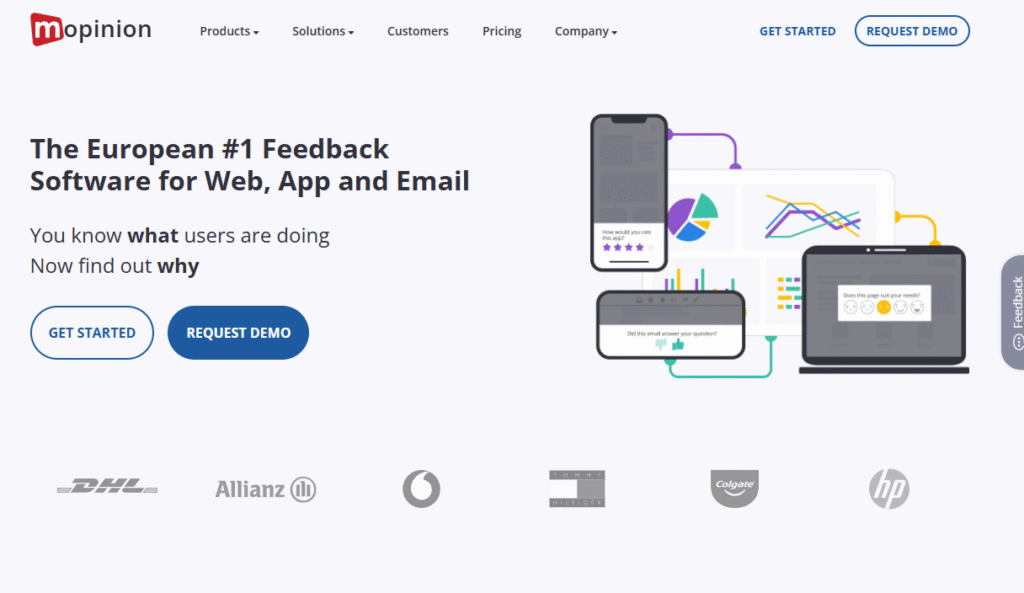
Mopinion is designed for companies handling large volumes of digital traffic — think eCommerce giants, banks, or enterprise SaaS firms. It collects customer feedback across websites, mobile apps, and email, then organises it into real-time dashboards for decision-making.
If you need high-volume feedback analysis with strong reporting, Mopinion is one of the most advanced platforms available.
Key Features
Customisable Feedback Forms
Create branded forms with conditional logic, star ratings, or open text fields. Great for capturing both quantitative and qualitative feedback.
Real-Time Dashboards
Monitor incoming responses live. Segment by device, location, or campaign to understand where pain points are happening.
Text & Sentiment Analysis
Automatically process open-text feedback using natural language processing (NLP). Spot themes, trends, and emotional tone without manual sorting.
Multi-Channel Coverage
Collect insights from web widgets, mobile SDKs, and email campaigns. Perfect for organisations with multiple customer touchpoints.
Role-Based Access
Set permissions for different departments. Marketing, product, and support teams can each see only the data relevant to their work.
Pros & Cons
| Pros | Cons |
| Real-time, enterprise-ready reporting | Overkill for small businesses |
| Sentiment analysis included | Steeper learning curve |
| Works across web + mobile | Pricing hidden behind quotes |
Pricing
- Custom Pricing – Based on traffic volume, number of users, and enterprise needs.
Best for Enterprises Collecting Large-Scale Feedback
Mopinion is a fit for:
- Enterprise eCommerce Teams — Optimise checkout funnels with web feedback
- Banks & Fintechs — Capture secure user insights across apps
- Digital Marketing Teams — Run campaign-specific feedback at scale
- CX Leaders — Share cross-department dashboards for unified action
If feedback volume overwhelms your current setup, Mopinion helps you process it at scale without drowning in raw data.
Use Mopinion for Checkout Abandonment Insights
Deploy exit surveys on your cart or checkout pages asking “What stopped you from completing your purchase?” The real-time dashboard will highlight your biggest blockers.
Best Alternative to Mopinion
UserReport – A lighter-weight option, great for connecting feedback to Google Analytics, though less powerful in enterprise reporting.
18. Askform – A Flexible Alternative to Traditional Surveys
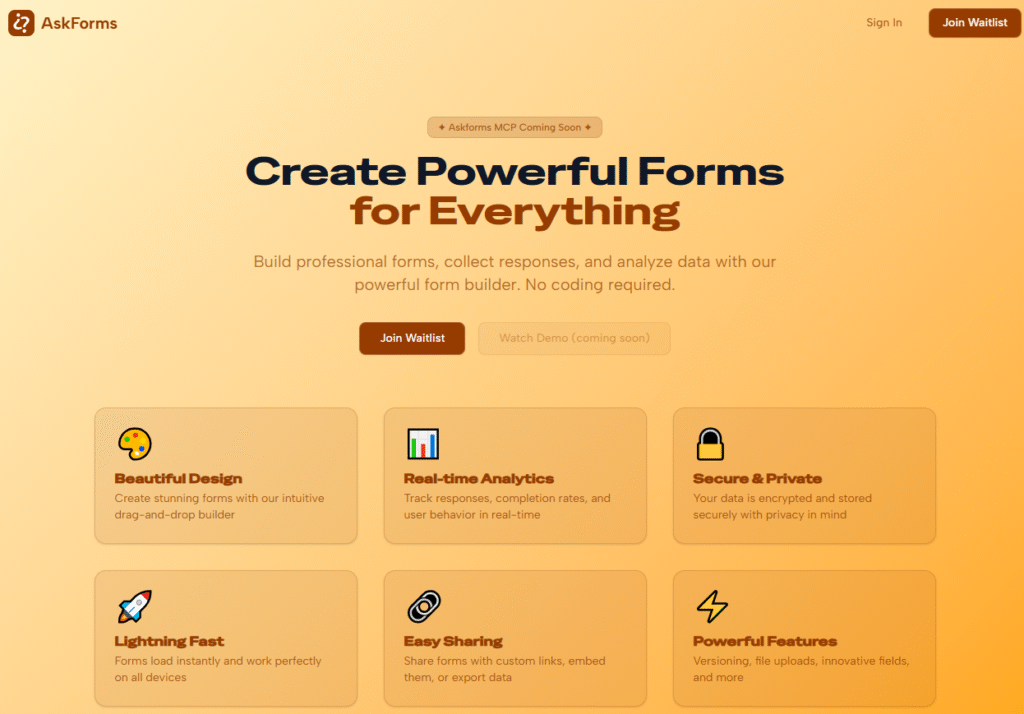
Askform is a rising survey tool designed for startups and mid-sized businesses that want engaging, logic-driven forms without the heavy pricing of big players like Typeform. Its clean interface and flexible logic builder make it especially useful for teams running research or onboarding surveys.
It’s less about flashy design and more about functionality and affordability.
Key Features
Smart Logic Builder
Create conditional paths so respondents only see questions relevant to them. Keeps surveys short and to the point.
Customisable Branding
Match surveys to your company’s style, ensuring they blend seamlessly with your site or product UI.
Multi-Channel Surveys
Send via link, email, or embed directly into your product. Adaptable to different workflows.
Analytics Dashboard
Track completion rates, response trends, and drop-off points to improve survey design over time.
Affordable Plans
Offers flexibility without locking core features behind expensive paywalls.
Pros & Cons
| Pros | Cons |
| Affordable compared to Typeform | Fewer templates available |
| Strong logic builder | Limited integrations |
| Clean, distraction-free interface | Smaller brand recognition |
Pricing
- Starter: $25/month
- Pro: $49/month
- Business: $99/month
Best for Budget-Conscious Teams Needing Flexible Surveys
Askform is great for:
- Startups — Get advanced survey logic without breaking the bank
- UX Researchers — Run user testing surveys with clean branching logic
- Marketers — Collect campaign feedback affordably
- SaaS Teams — Use embedded forms for onboarding and feature validation
If Typeform feels overpriced, Askform gives you nearly the same functionality at a leaner cost.
Use Askform to Improve Onboarding
Embed an Askform survey after users complete your onboarding flow. Ask which part was most confusing, then refine your process with minimal dev work.
Best Alternative to Askform
Typeform – Still the leader in design-focused forms, though more expensive. Worth it if brand image and UI aesthetics matter more than budget.
19. Zonka Feedback – Collect Feedback Anywhere, Even Offline
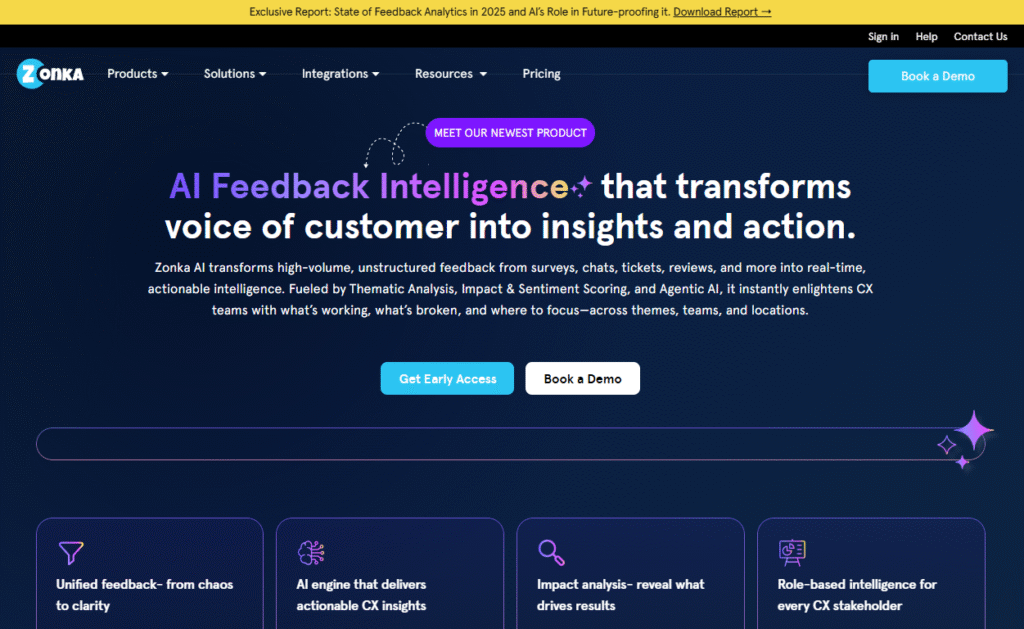
Zonka Feedback is a customer experience and survey platform that shines in omnichannel feedback collection, especially in offline environments. Unlike many competitors, it offers kiosk and tablet-based surveys, making it a strong choice for retail, healthcare, and hospitality businesses.
If you need consistent feedback from both online and offline touchpoints, Zonka Feedback is worth serious consideration.
Key Features
Offline Surveys on Tablets & Kiosks
Collect feedback in areas without internet access. Responses sync automatically once the device is online again.
Multi-Channel Distribution
Deploy surveys via email, SMS, website, in-app, or offline terminals — all managed from one dashboard.
White-Label Branding
Design surveys with full customisation to maintain brand consistency across every channel.
Advanced Question Types
Support for NPS, CSAT, CES, star ratings, and open text questions. Flexible enough to handle diverse feedback needs.
Actionable Reporting
Dashboards and alerts highlight negative responses so teams can take quick corrective action.
Pros & Cons
| Pros | Cons |
| Works offline — great for kiosks | UI not as sleek as Typeform |
| Covers all survey formats (NPS, CSAT) | Some advanced analytics cost extra |
| Good for healthcare, retail, events | Fewer SaaS-native integrations |
Pricing
- Professional: $49/month
- Growth: $99/month
- Enterprise: Custom pricing
Best for Omnichannel Businesses with Offline Touchpoints
Zonka Feedback is ideal for:
- Retail Stores — Collect on-site feedback via kiosk surveys
- Hospitals & Clinics — Gather patient satisfaction data offline
- Hospitality Teams — Use tablets at check-in or checkout
- Event organisers — Run surveys at conferences or trade shows
Zonka Feedback bridges the online–offline gap, ensuring you don’t miss feedback just because users aren’t on a laptop.
Use Zonka Feedback for Post-Visit Reviews
Install a kiosk at your store exit asking, “How was your visit today?” Simple, real-time responses will help you catch service issues instantly.
Best Alternative to Zonka Feedback
Feedier – Another strong omnichannel option, with gamification and rewards, but Zonka has the edge in offline and kiosk-based feedback collection.
20. Nicereply – Customer Feedback for Every Support Interaction
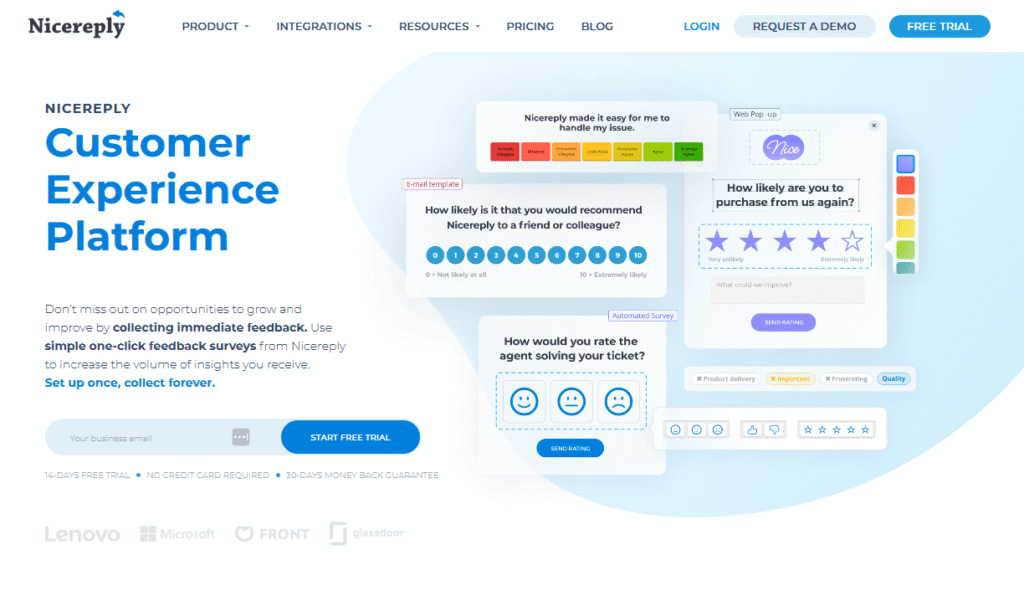
Nicereply is a customer feedback tool designed specifically for support and success teams. It integrates directly into helpdesk and CRM platforms, allowing businesses to measure CSAT, CES, and NPS scores after every customer interaction. Instead of running occasional surveys, Nicereply captures sentiment continuously at the ticket, chat, or call level.
This makes it a powerful tool for support-heavy businesses that want to track agent performance and customer experience in real time.
Key Features
Post-Interaction Surveys
Automatically send a survey after a ticket is closed, a chat session ends, or a call finishes. Keeps feedback relevant and timely.
Agent-Level Tracking
Tie survey results directly to the agent who handled the interaction. Great for performance management and coaching.
Multiple Feedback Types
Supports CSAT (Customer Satisfaction), CES (Customer Effort Score), and NPS (Net Promoter Score) in one platform.
Deep Integrations
Works with Zendesk, Freshdesk, Intercom, Help Scout, and Salesforce. Fits naturally into existing support workflows.
Reporting & Dashboards
Visualise trends by agent, team, or channel. Spot systemic issues or highlight top performers.
Pros & Cons
| Pros | Cons |
| Direct integration with helpdesks | Focused mainly on support teams |
| Tracks feedback per agent | Limited beyond post-interaction |
| Covers NPS, CSAT, and CES | Fewer enterprise analytics options |
Pricing
- Essential: $59/month
- Growth: $119/month
- Business: $239/month
- Enterprise: Custom pricing
Best for Support Teams Wanting Agent-Level Insights
Nicereply is best for:
- Customer Support Managers — Track team performance in real time
- CS Leaders — Monitor effort scores to reduce friction in support
- B2B SaaS Companies — Connect feedback to renewals and retention
- Contact Centers — Improve agent accountability and satisfaction
Nicereply makes customer feedback an everyday metric, not just a quarterly survey, giving managers a clearer view of service quality.
Use Nicereply for Performance Coaching
Set up dashboards showing agent-level CSAT trends. Use this data in 1:1 meetings to coach support reps and highlight top performers.
Best Alternative to Nicereply
AskNicely – Similar focus on service quality, but designed more around NPS workflows than ticket-level CSAT and CES tracking.
Why These 20 Feedback Tools Matter in 2025
Customer feedback is the lifeblood of any business — whether you’re running a SaaS platform, managing an eCommerce store, or leading a service-based company. The right tools don’t just collect opinions; they turn them into actionable insights that reduce churn, improve retention, and drive growth.
From enterprise-grade solutions like Qualtrics and Mopinion to lean startup-friendly options like Delighted and Refiner, there’s a feedback platform here for every stage and budget. The common thread? These tools help you listen to your customers and act on what they tell you.
If you’ve been relying on guesswork or occasional surveys, 2025 is the year to change that.
How Pearl Lemon Experiences Can Help
At Pearl Lemon Experiences, we don’t just recommend tools — we help you implement them as part of a bigger customer journey strategy. Our team specialises in designing feedback systems that do more than capture scores; they create actionable insights that shape decisions, improve customer retention, and refine your service experience.
Whether you need to integrate NPS surveys into your CRM, set up real-time alerts for detractors, or connect feedback to revenue metrics, we’ll make sure your business gets maximum value out of whichever tool you choose.
Ready to make customer feedback a true growth driver? Book a consultation with us today and let’s turn your feedback loop into your competitive edge.
FAQs
1. What is a customer feedback tool?
A customer feedback tool is software that helps businesses gather, organise, and analyse user opinions through surveys, in-app prompts, or reviews.
2. Why should I use customer feedback tools in 2025?
Because customer expectations are higher than ever. These tools help you identify issues, track sentiment, and act before churn happens.
3. Which customer feedback tool is best for SaaS?
Refiner and SatisMeter are excellent for SaaS because they integrate with product usage and trigger contextual in-app surveys.
4. What’s the most affordable feedback tool?
Typeform and Askform both offer budget-friendly plans starting around $25/month.
5. Which tool works best with Salesforce?
GetFeedback is purpose-built for Salesforce integration, making it ideal for teams already using the CRM.
6. Can I use feedback tools offline?
Yes. Zonka Feedback and Feedier allow for offline or kiosk-based surveys, perfect for retail and events.
7. Do these tools support multi-language surveys?
Yes, most major tools like Qualtrics, Mopinion, and AskNicely support multi-language deployment.
8. What’s the difference between NPS, CSAT, and CES?
- NPS: Measures loyalty and likelihood to recommend.
- CSAT: Measures satisfaction with a specific interaction.
- CES: Measures how easy it was for a customer to resolve an issue.
9. How do I choose the right tool?
Consider your business size, primary use case (support, product, marketing), and existing integrations before deciding.
10. Can Pearl Lemon Experiences help me implement these tools?
Yes. We’ll help you select the right tool, set it up, integrate it with your systems, and train your team on how to use it effectively.

